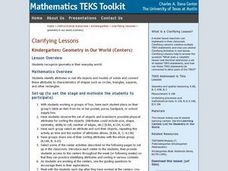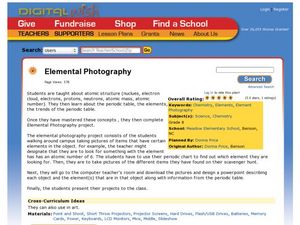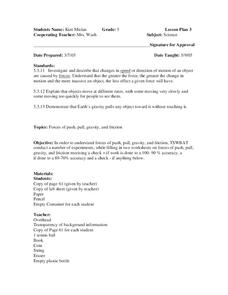Curated OER
Understanding Fractions
Students explore the parts of an orange to develop an understanding of the addition and subtraction of fractions. The concept of representing parts of a whole by dividing an object into smaller pieces is experienced in this hands-on...
Curated OER
Kindergarten: Geometry in Our World (Centers)
Students identify attributes in real-life objects and models of solids and connect these attributes to characteristics of shapes such as circles, triangles, squares, and other rectangles. They discuss the ability of the object to roll,...
Curated OER
The Mystery Box
Learners design a mystery box to hold an object related to the timeline of life studies. In this timeline of life lesson, student play a game with fossils and other remnants of past times and guess the era it comes from.
Curated OER
Sense of Touch
Students identify their five senses by reading a story. In this human anatomy lesson, students read the book, Here Are My Hands by Bill Martin Jr, and touch a variety of objects. Students describe and record each object they...
Curated OER
One Size Fits All?
Learners describe the differences between an estimate and a guess. They create reasonable estimates based on comparison and activities. Students explain how estimation is helpful in showing the relative size on a scale. They also...
Curated OER
What Is The Concept?
Students systemically determine the concept that the waste items placed in a "yes" category are biodegradable and those in the "no" category are not. This activity is a motivating way to introduce a unit on wastes by having students use...
Curated OER
Simple Machine Research
Fifth graders demonstrate the ability to use scientific skills and Processes to describe forces that act upon objects to cause specific changes in motion. They identify and describe a science problem related to forces and simple machines.
Curated OER
Where are you Spider?
First graders investigate the proximity of objects in space. In this proximity lesson, 1st graders place a felt spider in different locations on a teacher made book, and they describe its proximity to certain items in that book. Students...
Curated OER
Take Charge!
Students induce an electrical charge on various objects, and experiment with electrical repulsion and attraction. They define related vocabulary, play Bingo and complete a take-home quiz.
Curated OER
How Do Things Fall?
Students study forces by examining the force of gravitational attraction. They observe how objects fall and measure the force of gravitational attraction upon objects. Students discover that, since gravitational constants are different...
Curated OER
Hovercraft Racers!
Students gain first-hand experience on how friction affects motion. They build a hovercraft using air from a balloon to levitate a craft made from a compact disk (CD), learning that a bed of air under an object significantly reduces the...
Curated OER
The Castle
Students build a castle to Ravi's design using the cubes. Students then make an original model of a solid object from diagrams which show views from the top, front, side and back. Students describe the reflection of rotational symmetry...
Curated OER
Is a Pulley a Special Kind of Lever?
Fifth graders use information from their text to read and discuss pulleys and levers. They examine a top sketch of the arrangement of a fixed pulley. Working in groups, 5th graders perform experiments to test the effect of using a pulley...
Curated OER
The Family: Louisiana Family Folklore
Students explore and identify family treasures and research the history to each one. They also organize a variety of artifacts into various categories and research traditional Louisiana artifacts online. Each student draws inferences...
Curated OER
WS 5.6 Graham's Law
In this gases learning exercise, students use the concepts of Graham's Law of diffusion to determine the velocity of gases and molecules. They describe kinetic energy and how it relates to the mass and velocity of objects.
Curated OER
Elemental Photography
Eighth graders investigate objects for a specific element from the Periodic Table. In this elemental photography lesson, 8th graders observe for and object and photograph it. Students use photographs to prepare a multimedia...
Curated OER
Force
Fifth graders move a variety of objects in different ways to observe the different forces. In this physics lesson, 5th graders observe pushing, pulling, gravity, and friction. The hands-on component, and teamwork involved, should make...
Curated OER
Building Buildings
Seventh graders investigate 2-D and 3-D objects. In this geometry lesson, 7th graders begin to understand spatial reasoning. Students look at pictures of the NYC Skyline and discuss what it looks like from different views. Students use...
Curated OER
Rock-A-Bye Pendulum
Third graders analyze the effects of force on an object in motion and its relationship to a change in speed. This lesson uses a pendulum to demonstrate the principle.
Curated OER
Magnets
Second graders classify objects and create hypotheses regarding their magnetic properties. They watch a video about magnets and finally use a magnet to test their hypotheses created earlier.
Curated OER
Solar System Planet Research
In this space science worksheet, students collect data that includes information in a chart or graph to display in a group. They identify and describe various planet features of a specific planet of choice. Students write notes and the...
Curated OER
Azimuth and Altitude
In this azimuth and altitude worksheet, students answer fifteen questions about measurements of objects in the sky using a compass and an inclinometer.
Curated OER
Internet Measurement
Students become familiar with how to get information from the Internet. In this math and technology lesson plan, students measure objects on a measurement sheet found on a web site. They practice using a standard unit of measurement...
Curated OER
What is the Attraction?
Second graders investigate the law of polarity. In this magnets lesson, 2nd graders discover how magnets are used in everyday life and which objects in our environment are magnetic. Students experiment with bar magnets and record...























